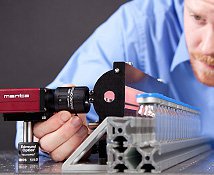Not All Imaging Lenses Are Created Equal - Lab Example
Want better imaging system performance? It all starts with the optics!

The success of your machine vision application depends on the quality of your optics in order to ensure accuracy, repeatability, and speed. Not only do these characteristics play a critical role in system performance, but more importantly they directly impact your bottom line and overall customer satisfaction. For the best price to performance ratio, Edmund Optics' imaging components are the perfect choice to take you from design to prototype to volume production. Plus, with an expert imaging support team and downloadable engineering files – we make integration easy! Don't just take our word for it, take it from someone you trust – you. To discuss your next project and if you qualify for a free evaluation sample, contact us today.
Lab Report: Edmund Optics Imaging Lens Comparison
Objective: To disprove the common myth that optics really don't matter in imaging systems, we tested an Edmund Optics designed and manufactured compact fixed focal (CFF) lens against a leading competitive product. We used lenses with the same design (fixed focal), focal length (16mm), and settings (f/2.8) to demonstrate that Better Optics = Better System Performance.
Equipment:
- #84-363 Allied Vision Manta G-504 Monochrome CCD Camera, 5MP Resolution, 2/3" Format
- #58-835 101 x 101mm Glass Star Array Target
- #59-870 16mm Compact Fixed Focal Length Lens, Set at f/2.8
- Competitor 16mm Fixed Focal Length Lens, Set at f/2.8
- Diffuse Line Light
Method: A row of coded insulin bottles was set a distance away from the Edmund Optics 16mm C Series Fixed Focal Length Lens and camera such that the field of view contained three bottles side-by-side, with the bottles' 2D data matrices facing the camera. Care was taken to arrange the bottles linearly in a plane perpendicular to the imaging-axis. The diffuse line light was placed between the camera and the bottles so that the camera was "looking-through" the light, and the light was aligned for even illumination across the field of view. A fixture (rail) was used for co-planar alignment of the bottles and the camera angle was adjusted to find best focus for the two outer bottles, simultaneously, ensuring that the object plane was not tilted.
Imaging Results: The same testing method and setup was used to produce images for both the Edmund Optics 16mm C Series Fixed Focal Length Lens and the competitor's lens. Both lens apertures were set to f/2.8, and the working distance remained the same. The shutter (exposure time) was unchanged between lenses. Compare the contrast and readability of the codes at the center and at the edges of the images. While the competitor's lens allows for a good focus on-axis, there is considerable blurring and a decrease in contrast for the codes on the left and right. The Edmund Optics lens performed equally well on-axis and off-axis.

Edmund Optics (Top) – Good Performance Across Entire Image
High contrast image across entire field of view for #59-870 16mm Compact Fixed Focal Length Lens set at f/2.8.
Competitor (Bottom) – Reduced Performance at Edges
Aberrations evident at edges despite best focus at center for the competitor 16mm Compact Fixed Focal Length Lens set at f/2.8.

Figure 1: Data Matrix Scanning
Conclusions: Overall image quality can be degraded by a combination of any of a number of specific aberrations. Evident in the imaging results, the competitor's lens suffers from field-curvature issues which make achieving a sharp focus on a plane across the full field impossible. Edmund Optics' 16mm C Series Fixed Focal Length Lens maintains sharp focus across the entire field, allowing for clear reading of three codes simultaneously with high contrast, which, in this case, increases reliability and permits increasing the rate of the line and, subsequently, the system throughput. In a real-world application this means you achieve high resolution and high quality images anywhere within the specified field of the view of the lens. Images are truly worth a thousand words, and we've shown you why Better Optics = Better System Performance.
Lab Report: From the Real-World to the Lab
To test the variances in resolution among different imaging lenses, we encourage you to do such a comparison yourself. A simple method for comparing an objective is to use a test target, such as #58-835 Star Target Array, to conduct a qualitative assessment of lens performance over the entire field of view. Choose an f/# and keep it the same for each lens that you wish to compare – slow (high) f/#s tend to limit performance due to diffraction, while a wide open aperture allows more aberrated rays to pass through the lens. By examining the star target at various portions of the image, you can assess the overall image quality. Comparing stars at opposite ends of the field will allow you to ensure that there is no tilt in optical axis the system. Differences in resolution in the vertical and horizontal of the stars will indicate astigmatism, while differences in the center and corners will indicate field curvature and off-axis aberrations such as coma.
Edmund Optics (Left) Competitor (Right)



Figures 2b - 2d (Right): Edmund Optics #59-870 16mm Compact Fixed Focal Length Lens set at f/2.8 provides high contrast and quality across entire field of view. The competitor 16mm Compact Fixed Focal Length Lens set at f/2.8 only provides comparable quality in the center of the image.
It is evident that off-axis aberrations are present in the competitor lens in the bottom of the star target thus reducing image quality and decreasing contrast. In the corner of the star target, the magnitude of aberrations makes for an unusable image in the competitor lens.


















or view regional numbers
QUOTE TOOL
enter stock numbers to begin
Copyright 2023 | Edmund Optics, Ltd Unit 1, Opus Avenue, Nether Poppleton, York, YO26 6BL, UK
California Consumer Privacy Acts (CCPA): Do Not Sell or Share My Personal Information
California Transparency in Supply Chains Act